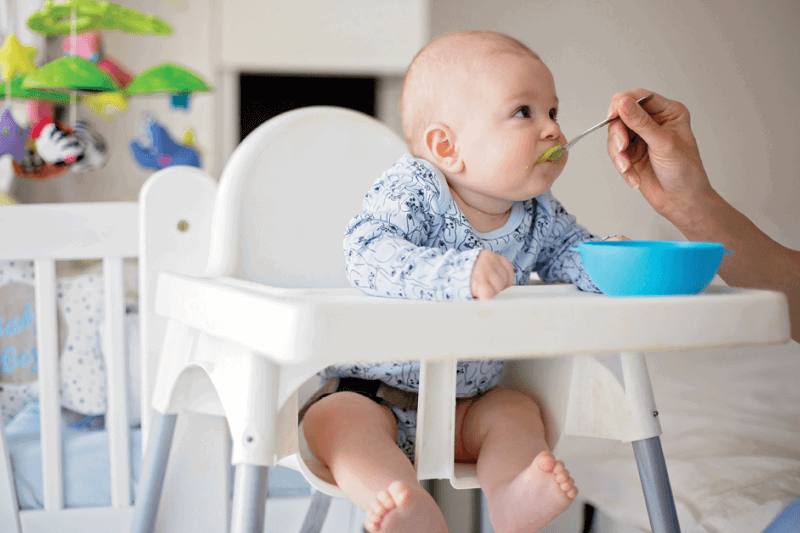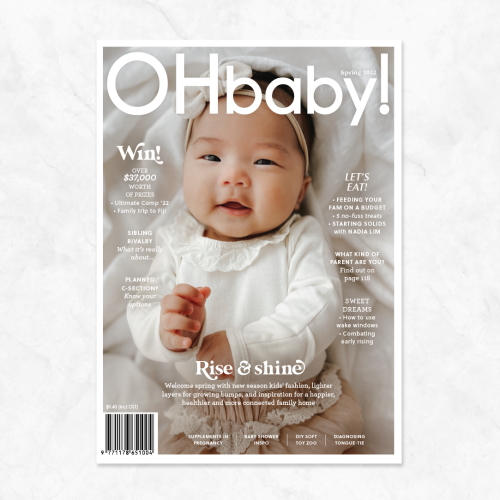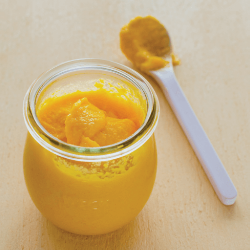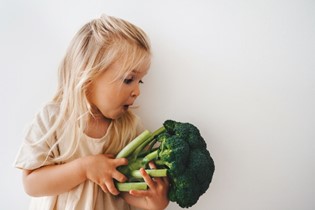Tips from Nadia Lim on growing great eating habits

Making mealtimes a positive, enjoyable experience is one of the best things you can do to set your baby up for a lifetime of great eating habits, Nadia Lim explains...
The starting solids journey is an exciting one for both you and baby – it’s a bit of a milestone when your little one transitions from milk alone to exploring solid foods. There’s no rush to start solids – wait until baby is ready, which is usually when they are about 6 months old. It’s recommended that baby starts on some solid foods at around 6 months because at this stage baby can no longer meet all their nutritional requirements from breast milk alone (especially iron, which is very important for their growth and development).
When your baby is ready to start on solids, you should continue milk feeding on demand as milk gives your baby most of their energy needs, as well as a plethora of important nutrients. The focus when starting solids is for fun food exploration and keeping mealtimes enjoyable and relaxed. Embrace the mess (and be prepared for lots of washing!) as your baby will want to see, touch, and smell the food before they finally taste and eat it. Allowing your baby to explore food helps create a healthy, confident eater.
WHEN TO START
When your baby is ready, around 6 months but not before 4 months, they can start on solid foods. Your baby’s gut is not mature enough to cope with anything other than milk before 4 months of age and it is likely your baby will not have the physical co-ordination to open their mouth for food, keep the food in their mouth and swallow it in a safe way. Earlier introduction of solids often comes with the hope that baby will sleep through the night longer, however this is not a given (as babies waking through the night is normal and happens for multiple reasons).
SIGNS THAT YOUR BABY IS READY FOR SOLID FOOD
+ They can hold their head up
+ They can sit with less help
+ They open their mouth when food approaches
+ They can keep food in their mouth without pushing it back out
+ They are showing signs of biting and chewing
For premature babies (born before 37 weeks gestation), the current recommendation is that they should still start solid foods at around 6 months of their ‘actual’ age, rather than ‘corrected’ age to avoid delays in gaining the additional nutrients needed for their development. Premature infants may need help with starting solids from a speech and language therapist.
With both my boys it was very clear that they were ready to start on solids around four and a half months of age. I remember Bodhi literally reaching out and grabbing a piece of pumpkin from my fork. He was so interested. With River we were all sitting around the dining table and he kept whining because all he wanted was a lamb chop!

HOW TO START
There are two common approaches to starting solids: spoon feeding and baby-led weaning. They are not mutually exclusive, and it can work well to try a bit of both!
SPOON FEEDING
Spoon feeding is the more common way of starting baby on solids. Spoon feeding starts with feeding your baby family foods in a puree form, progressing to having more texture, and then finger foods when they are ready. The basic steps for spoon feeding are:
+ Runny puree (at about 4–6 months of age). Texture is like smooth pumpkin soup.
+ Thick puree (at about 6–7 months of age). Texture is like smooth mashed potato.
+ Small, lumpy, soft textures (at about 7–8 months), eg quinoa/rice mixed into puree.
+ Finger foods (at about 8 months of age) eg chunks of soft fruit or cooked vegetable sticks. The food should be able to be squashed in between your thumb and index finger.
+ Large, lumpy, soft textures (at about 8–10 months of age), eg risotto.
+ Whole, chopped, family foods by 12 months of age.
The above ages for texture progression are just a guide and your baby will tell you when they are ready to progress to the next stage. You will know your baby is struggling if they are gagging, pushing the food out their mouth, or spitting out the food. Return to the previous texture and try the next step again in another weeks time. Seek help from your health professional (eg a WellChild nurse or dietitian) if baby is not managing lumpy foods, or finger foods by 10 months of age.
It is important to introduce lumpy foods (eg soft pieces of vegetable, rice, pasta, soft proteins such as fish and cooked lentils) by 8–10 months along with finger foods from 8 months to progress your baby’s chewing skills. Increasing texture and chewing foods helps your baby develop oral motor skills that will be useful for speech development.
Your baby will start with only having a small amount of food. The focus at this stage is the experience of eating in a relaxed, fun and positive environment. Some babies may like to hold the spoon themselves, so feeding with two spoons (where baby can hold one and you can hold one) is a great way to keep them engaged.
Some purees to start your baby on
+ Pureed veg such as pumpkin, kūmara, carrot, parsnip, broccoli, peas, avocado
+ Pureed beef/lamb/chicken/cooked egg/lentils
+ Pureed fruit such as stewed apple/pear/peach
+ Yogurt (eg dairy, coconut, soy), preferably full fat and unsweetened
+ Iron-fortified baby cereals mixed with breast milk or formula, along with other wholefoods such as fruit, veges, or meat added.
BABY-LED WEANING
Baby-led weaning (BLW) is when your baby feeds themselves all their food, rather than being spoon-fed by a parent. This means the food needs to be the right size, shape and texture (softness) so they can hold and manage it themselves. Your baby should be at least 6 months of age before trying BLW, as they are unlikely to be developmentally ready before then. If your baby is showing signs they are ready to start solid foods before 6 months of age, or they have developmental delay, you should start by offering pureed foods then progress to safe finger foods once they are
6 months.
How it works
Try offering your baby a range of foods (two to three different types) that they can easily pick up and feed to themselves.
Size
When starting, foods should be in long finger strips (around the length of their hand and a thickness that they can easily hold in their fist) so that there is enough food to hold on to, as well as enough to put in their mouth. As your baby gets older the size of the pieces of food can get smaller as they begin to be developmentally ready (ie they have a pincer grip with the thumb and forefinger) for managing smaller pieces of food.
Texture
When starting, foods should be soft enough that when you test it, your tongue can squash the food to the roof of your mouth. You can move to firmer textures as your baby gets older. Many parents feel concerned about choking with baby-led weaning, so getting the texture and types of food offered right early on is important to prevent this from occurring, even if it is rare.
Appropriate baby-led weaning foods to start baby on
+ Peeled vegetables, either steamed or roasted, eg pumpkin, kūmara, carrot, broccoli (cut into hand-length pieces).
+ Beef, lamb or venison strips, cooked medium, or lamb cutlets or pork/lamb ribs – if you are concerned about your baby choking you can use a mesh feeder to allow baby to suck the juices out (this is where the iron is, after all!).
+ Softer fruits in palm-sized portions, eg banana, soft pear, soft stone fruits (stones and skins removed).
+ Toast fingers with avocado, hummus, smooth peanut butter, or pureed meat on top.
+ Iron-fortified baby cereal mixed with breast milk/formula and spread on vegetables, or used to dip soft fruit or veg into.
+ Pureed and smooth foods can still be offered in a handheld way – try using other foods such as strips of toast, vegetable sticks or rusks as a vehicle for spreading purees on which baby can then feed themselves with.
WHICH APPROACH TO STARTING SOLIDS IS BEST?
When it comes to starting solids, how you feed your baby is up to you and your baby. A combination of the two ways can work well, as there will be times of the day baby might want to be fed by you when they are tired, and times when they want to be an independent, explorative eater. Research shows that there really is not much difference between choosing a baby-led or puree spoon-feeding approach in terms of nutritional quality, choking risk and growth, if the right types of foods are offered (particularly iron-rich foods) and the safety around avoiding high choking risk foods is observed. Your baby will help you make this decision; they will show you how they want to be fed.
HOW MUCH AND HOW OFTEN?
When baby first starts on solids, they may only try a teaspoon of food at the first few meals, but as long as baby has a positive experience, you’re on the right track. Start with just one meal per day and choose a time of day when both you and your baby are happy and relaxed. Avoid choosing a time when there are a lot of other things going on – for example, just before you need to rush off to daycare/school pick-up, or a time when you know they are usually unsettled. Increase to two meals and then three meals as your baby is ready. As a general guide you can increase the number of meals when they seem to manage around two tablespoons of food at the mealtime. Every baby does this at their own pace. Some babies absolutely love solid foods and are keen to increase to three meals within a few weeks. Other babies are not so keen on solid foods initially and take a few months to get to three meals per day. Trust your baby to guide you on this.
YOUR BABY WILL TELL YOU THEY HAVE HAD ENOUGH FOOD BY:
+ Closing their mouth when you present food to them
+ Turning their head away from the food
+ Pushing the spoon, food, or plate away
+ Spitting out the food
+ Pressing their lips together
+ Becoming upset or crying
MILK OR SOLIDS FIRST AT MEALTIMES?
Solid food should complement milk feeds, not be a replacement. Milk feeding can continue on demand over the day and night, and this will play an important role in maintaining good breast milk supply (remember the principles of how demand and supply work).
For the first few months after starting solids, you can breastfeed/bottle feed your baby before giving them solids to help them relax. Breast milk prior to solids can help your baby digest foods, especially starchy foods as there is amylase (an enzyme) contained in breast milk that aids starch digestion. Continue giving milk feeds before solid foods until your baby is established on solid foods. Once they are enjoying good portions of food you can switch to giving food first and milk feeds after. This happens at about 8–9 months. By around 12 months of age your baby is likely to be on three meals and possibly an extra snack, depending on their naps over the day. These meals and snacks would be given before milk.
IRON DEFICIENCIES
Young children are at risk of iron deficiency due to their high rate of growth. Introducing solid food at around 6 months is important as breast milk alone is no longer able to meet their nutritional requirements for iron. Stores of iron in the body begin to reduce at around 6 months of age, and therefore solid foods containing iron such as meat/fish/chicken/lentils/beans and iron-fortified baby cereals should be offered daily. Adding vitamin C-rich fruits and vegetables to meals containing iron can help with its absorption. It is tempting to offer your baby just fruits and veggies when starting on solids as they are often the right texture and easy to prepare, however, it's important to be offering baby high-iron foods as well, regardless of how you feed baby.
Great high-iron purees to start your baby on:
+ Pureed beef/lamb/venison mixed with breast milk, formula or veg puree
+ Pureed chicken mixed with breast milk or formula
+ Pureed cooked egg
+ Pureed legumes (such as lentils). Add some vitamin C-rich veggies, such as capsicum or carrot
+ Iron-fortified baby cereal mixed with breast milk or formula with added vitamin C-rich fruit or veg, such as pureed spinach, apple or mango
Some great high-iron, baby-led weaning foods are:
+ Strips or cutlets of cooked red meat such as lamb, beef or venison (you can use a mesh feeder if you are concerned about choking)
+ Minced meat (beef, lamb, chicken) in cooked patties
+ Iron-fortified baby cereal (can be added to baking)
+ Hummus/pureed meat spread on soft veggie sticks or a strip of toast (boost the iron content by adding some iron -fortified baby cereal)
WHAT TO FEED BABY
In the first 12 months you want to expose your baby to as wide a variety of foods as possible, with a focus on foods your family regularly eats as well as wholefood groups such as vegetables in all the colours of the rainbow, protein foods, fruit, milk products, grains, and fats and oils.
Babies are generally willing to try new foods, so expose them to as many different tastes and textures as possible. Putting in the groundwork at this age means they are likely to overcome their normal ‘fussy’ stage as a toddler much quicker. Starting your baby with vegetables as their first tastes can be useful to encourage acceptance of veggies throughout their life. It is important to offer ‘bitter’ vegetables regularly, eg broccoli, cauliflower, kale, spinach and to not always mix them with fruit or sweet vegetables. Savoury meals are important over the day to challenge their natural ‘sweet tooth’. You can also puree like-coloured veggies together to expose your baby to different coloured foods, such as mixing pumpkin and carrot, or mixing peas and broccoli. Don't be afraid of flavour as most babies love having added herbs and spices (without added salt or sugar) in their meals.
Check out these recipes from 'YUM! Recipes and nutrition for the whole family'



AS FEATURED IN ISSUE 59 OF OHbaby! MAGAZINE. CHECK OUT OTHER ARTICLES IN THIS ISSUE BELOW





















